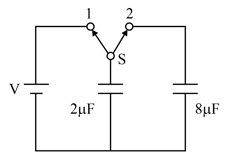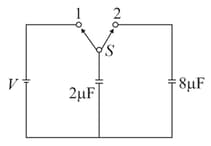Potential Energy of a System of Charges
Potential Energy of a System of Charges: Overview
This topic covers concepts such as Electrostatic Potential Energy, Electrostatic Potential Energy between Two Point Charges, and Electrostatic Potential Energy of System of Point Charges.
Important Questions on Potential Energy of a System of Charges
The term ‘potential energy’ of charge ‘q’ at a distance ‘r’ in an external electric field can be defined as:.
Two point charges C and C are separated by a distance of 50 cm in air.
(i) Find the point on the line joining the charges, where the electric potential is zero.
(ii) Also find the electrostatic potential energy of the system.
What is the radius (in ) of the imaginary concentric sphere that divides the electrostatic field of a metal sphere of a radius & a charge of in two regions of identical energy -
Three charges, and , are placed at equal distances, on a straight line. If the potential energy of the system of three charges is zero, then what is the ratio of ?
Three charges, and , are placed at equal distances, on a straight line. If the potential energy of the system of three charges is zero, then what is the ratio of ?

A capacitor of is charged as shown in the diagram. When the switch is turned to position the percentage of its stored energy dissipated is:
Consider a sphere of radius with uniform charged density and total charge The electrostatic potential distribution inside the sphere is given by
Note that the zero of potential is at infinity. The values of are:

A capacitor of is charged as shown in the diagram. When the switch is turned to position the percentage of its stored energy dissipated is:
A charged particle is shot towards another charged particle which is fixed, with a speed. It approaches up to the closest distance and then returns. If is shot with speed , the closest distance of approach would be
What is the radius (in ) of the imaginary concentric sphere that divides the electrostatic field of a metal sphere of a radius and charge of in two regions of identical energy?
Three charges, and respectively are placed at the vertices of an equilateral triangle of side . Find the value of for which the potential energy of system becomes zero.
No external electric field is applied on a system of two charges and located at and Determine the electrostatic potential energy of this system. (b) How much work is needed to make the charges separate by infinite distance.
How much work has to be done in putting charges respectively at the corners of an equilateral triangle of side ''.
Find the work done in bringing another charge from infinity to a point at a distance from a point charge .
Four charges, and respectively are placed on corners of a square of edge . Find the electric potential at the centre of the square.
If the electric potentials at two points A and B are and respectively, then find the work need to move a charge from A to B.
of work is needed to move a point charge between two points. Find the potential difference between the two points.
Two charges and are apart. To decreases the separation to . How much work has to be done?
Write expression for electrostatic potential energy for a system of two point charges and placed at positions given by position vectors and in a uniform electric field.
What is meant by electrostatic potential energy? Derive expression for potential energy of a system of point charges.
